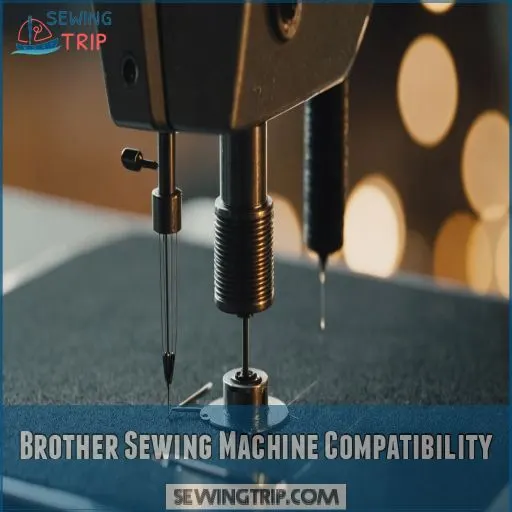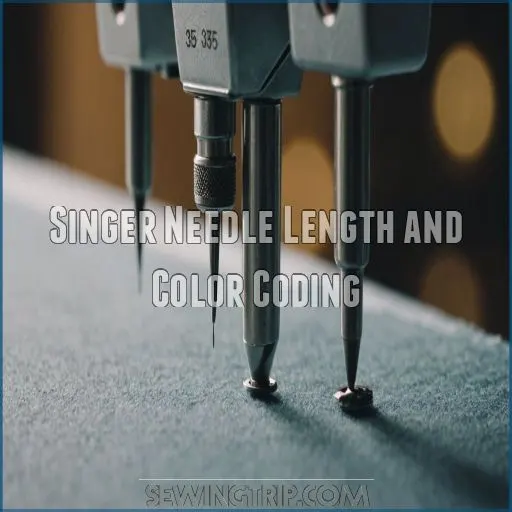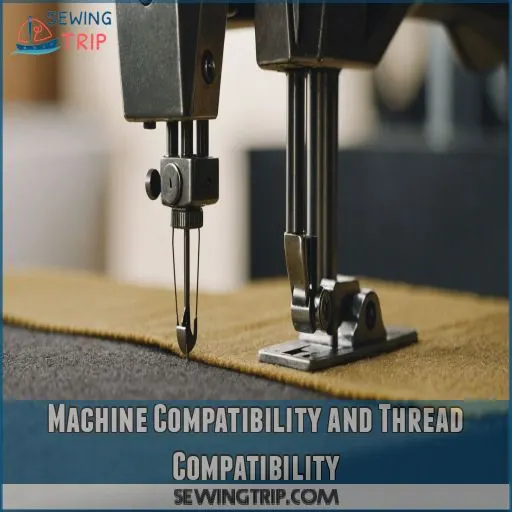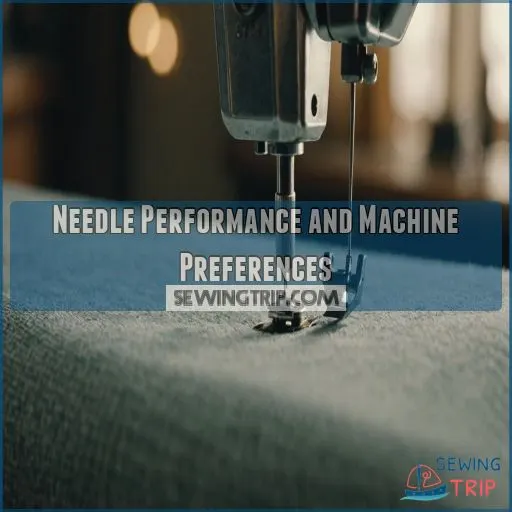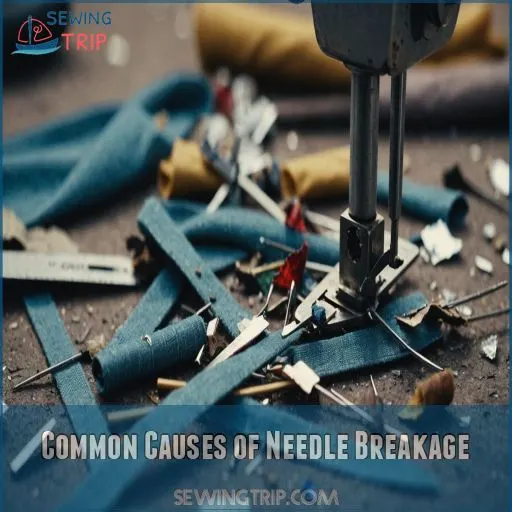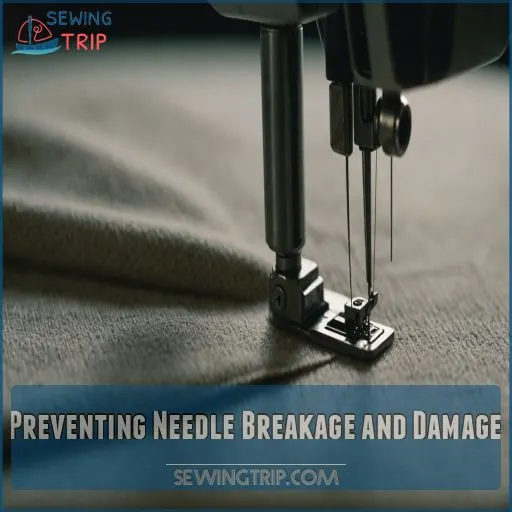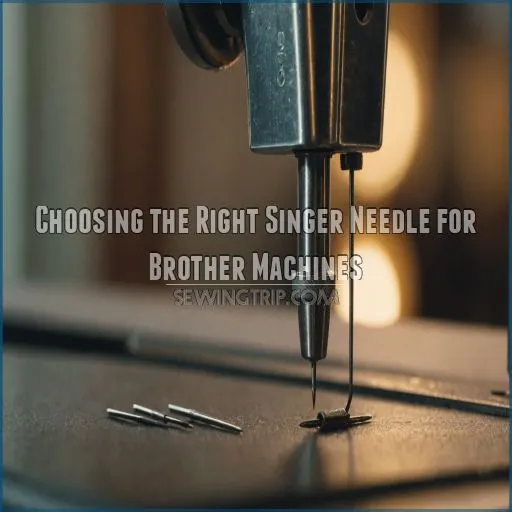This site is supported by our readers. We may earn a commission, at no cost to you, if you purchase through links.
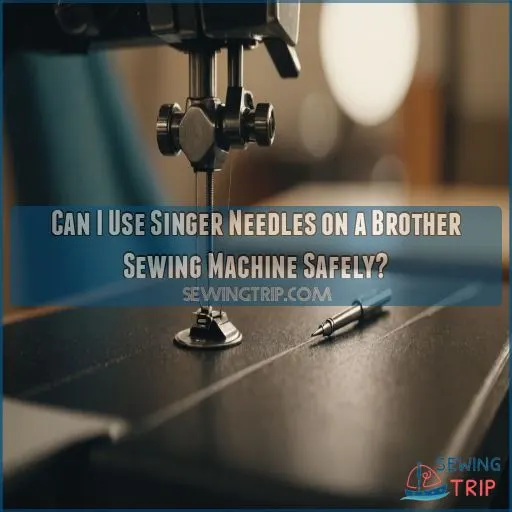
Although Singer needles are slightly longer, they usually work just fine. It’s a bit like trying on a pair of pants from a different brand—they might fit a tad differently, but they still do the job.
When selecting needles, consider your fabric type and thread thickness. Testing different sizes and types leads to sewing mastery.
Keep reading for tips on keeping your stitches flawless and avoiding needle breakage!
Table Of Contents
- Key Takeaways
- Brother Sewing Machine Compatibility
- Singer Needle Length and Color Coding
- Machine Compatibility and Thread Compatibility
- Needle Performance and Machine Preferences
- Common Causes of Needle Breakage
- Preventing Needle Breakage and Damage
- Choosing the Right Singer Needle for Brother Machines
- Frequently Asked Questions (FAQs)
- Conclusion
Key Takeaways
- You can confidently use Singer needles in your Brother sewing machine, thanks to the universal 15×1 needle system—it’s like finding the perfect dance partner.
- When choosing Singer needles, consider your fabric type and thread thickness to ensure smooth, flawless stitches. It’s all about finding the perfect needle-fabric match, just like picking the right pair of shoes.
- Refer to your Brother machine’s manual for specific needle recommendations to avoid any potential issues, such as needle breakage or thread tangles. It’s your trusty sewing sidekick, filled with all the tips you need.
- Experiment with different Singer needle sizes and types to master your sewing projects. It’s like a sewing treasure hunt—the more you explore, the more stitching success you’ll uncover.
Brother Sewing Machine Compatibility
If you’re wondering whether Singer needles can cozy up to your Brother sewing machine, you’re in luck!
Thanks to the universal 151 needle system, they’re a compatible match—just like peanut butter and jelly, but for sewing.
Universal 151 Needle System
You’ve got a Brother sewing machine and wonder about popping in a Universal 151 needle?
Think of it like finding the right dance partner—compatibility matters! The 151 needle system offers standardized sizes, but it’s always wise to check compatibility charts: they’re your secret weapon against needle jams or breakages.
Needle compatibility can save your project and your sanity!
Singer Needle Compatibility
The good news is that Singer needles are generally compatible with your Brother sewing machine.
Singer needles follow the universal 15×1 needle system, which is widely used across domestic sewing machine brands.
However, it’s always a good idea to check your machine’s manual to make sure you get the best performance and avoid any potential damage, especially for the best Brother sewing machine.
Needle Type and Size Considerations
Choosing the right needle type and size for your Brother machine? It’s like finding the perfect pair of jeans—fit matters. Singer needles can work, but consider fabric weight and stitch density.
Using inappropriate needles, like ones too long, could harm your machine.
Stay sharp with:
- Correct needle point for fabric
- Matching thread size
- Proper needle length
Happy sewing!
Checking the Brother Machine Manual
Before diving into needle adventures, grab your Brother sewing machine manual. It’s your trusty guidebook, filled with needle recommendations and troubleshooting tips.
Need to know about sewing machine needle types or sizes? It’s all in there. Plus, you’ll find maintenance guides, warranty info, and sewing accessories details—your one-stop shop for avoiding sewing machine needle breakage and mishaps.
Singer Needle Length and Color Coding
When you’re considering using Singer needles on your Brother sewing machine, it’s essential to understand the variations in needle length and the color-coding system Singer uses.
You’ll find that Singer needles are a touch longer, and their colorful shanks can look like a rainbow, each hue helping to crack the code on choosing the right point type and size for your sewing adventure!
Needle Length Variations
As you explore Singer and Brother needle compatibility, needle length affects stitches and fabric impact.
Even in the sewing world, size matters! Needle size differences and shank length can make all the difference.
Keep your machine humming smoothly by choosing the needles that match your fabric’s thickness, maintaining your needle threading for flawless finishes. Enjoy mastering your textile projects!
Color-Coding for Point Type and Size
When you’re exploring the colorful world of Singer needles, remember that each color is a roadmap to your sewing success.
Red means business with woven fabrics, while blue takes on denim like a champ (Source).
By knowing your needle colors, you’ll confidently match the needle to your fabric, ensuring your Brother sewing machine’s happy stitching with the right choice, such as using red for woven fabrics and adjusting the sewing machine stitch length accordingly
.
Understanding the Color Code System
Figuring out Singer needle types is like mastering a secret language!
Their color code meanings reveal needle size and purpose: red for woven, yellow for knits, blue for denim, and more .
Sizes range from green (extra fine) to violet (heavy).
Whether you’re tackling knits with a ballpoint or denim with a sharp needle, understanding this needle compatibility compass is your guide.
Implications for Brother Machine Users
Feeling adventurous with sewing? Singer needles might fit your Brother machine, but their length could affect performance and thread compatibility, particularly with European machines that have tighter tolerances.
A quick peek at your Brother manual will shed light on this, especially when considering the Singer Needle Compatibility. Needle quality and tension matter, so compare Singer needles before proceeding.
Explore, but make sure your stitches are sharp and stress-free—much like finding the perfect pair of shoes!
Machine Compatibility and Thread Compatibility
Wondering if your Brother sewing machine can handle Singer needles without throwing a needle tantrum?
You’re in luck—these two brands generally play nice together, making it easy to stitch your next masterpiece without drama!
Brother Machines and Singer Needle Compatibility
While Brother machines generally don’t mind using Singer needles, it’s wise to check the needle length before jumping in.
Some users have noted the potential for breakage due to slight variations in length.
Always make sure thread compatibility—Brother machines can be a bit picky.
Test different needle types to find what works best without causing a stitchy situation!
Other Machine Brands and Singer Needle Compatibility
Got a Brother sewing machine and wondering if Singer needles fit like a glove on different brands, especially when using a double needle setup
? Don’t fret—compatibility extends to machines like Kenmore and even some Viking models.
But tread carefully with European brands like Bernina, where needle shank variations could cause mayhem.
Singer needle length varies, affecting machines differently:
- Kenmore machines
- Viking machines
- European machines
- Needle shank variations
- Singer needles
Thread Type and Needle Compatibility
Piecing together thread gauge, needle size, and fabric type might seem like decoding a secret message.
Whether you’re using Singer needles on Brother sewing machines or any other combo, remember these factors: thread quality determines the needed needle size.
Stitch length and tension settings make sure harmony.
Trust your instincts—like knowing when fabrics deserve a little TLC.
Factors Affecting Compatibility
You’ve got needle compatibility on your mind, eh? Think about needle size, thread thickness, and fabric type, as these impact your Brother sewing machine’s performance when working with 37 built-in stitches
.
Using the right needle type is like picking the perfect puzzle piece.
Manufacturer recommendations suggest Singer needles work, but always double-check compatibility to avoid hiccups. After all, we don’t want a thread-tastrophe!
Needle Performance and Machine Preferences
Sewing machine needles, their quality and compatibility, can make all the difference.
Whether you’re working with a Brother or Singer machine, understanding the unique performance characteristics of different needle types and brands is important for achieving the best results.
Needle Quality and Brand Differences
Needle quality and brand differences can be a head-scratcher!
Singer needles, despite skepticism, often work fine in Brother machines. It’s like choosing between chocolate and vanilla—each has its perks.
Schmetz needles are popular, balancing quality and variety.
Remember, compatibility and stitch quality vary by brand and type, so keep experimenting for that perfect stitch compatibility!
Optimal Needles for Specific Fabrics and Threads
Picking the best needle is like finding the perfect pair of shoes—fit matters! For lightweight fabrics, use fine needles like 75/11. Tougher materials like denim? Grab a 90/14 needle.
- Ballpoint needles for knits to avoid snags.
- Denim needles for heavyweight fabrics.
- Choose needle size to match fabric and thread weight.
Factors Affecting Needle Performance
So you’ve mastered which needles pair best with specific fabrics.
Now, needle performance is influenced by quality, fabric type, thread thickness, speed, and maintenance.
Here’s a handy guide:
| Factor | Impact |
|---|---|
| Needle Quality | Durability |
| Fabric Type | Stitch Consistency |
| Thread Thickness | Smooth Sewing |
| Sewing Speed | Reduced Breakage |
| Needle Maintenance | Long-lasting Use |
Understanding these helps your Singer needles thrive in a Brother machine!
Machine-Specific Needle Recommendations
Have you ever wondered if using Singer needles on your Brother machine will start a revolution? Here’s the scoop: focus on machine compatibility, needle size, and type to make sure things run smoothly.
Choosing the wrong needle can lead to issues like skipped stitches or excessive thread breakage. It’s also essential to think about matching needle type to fabric fiber content (https://sewingtrip.com/what-sewing-machine-needle-to-use/), such as using a ballpoint needle for stretchy fabrics.
- Check your manual for recommendations.
- Use Universal or Schmetz needles.
- Match needle size to fabric type.
- Avoid skipping stitches or excessive thread breakage.
Common Causes of Needle Breakage
Even when you’re using the right needle, it doesn’t always mean you’re safe from the woes of needle breakage.
Singer needles on Brother machines are particularly susceptible to this issue.
High speeds and improper tension can lead to breakage faster than a cat unraveling a ball of yarn!
Metal Fatigue and Repeated Bending
Needle care is as important as your morning coffee; ignore it, and you’ll have stitch chaos on your hands.
Metal fatigue occurs when needles bend repeatedly, weakening over time. Prevent issues by regularly replacing sharp needles like leather or metallic ones.
With proper needle lifespan habits, your Singer needles keep your Brother sewing machine humming smoothly.
High Sewing Speeds and Needle Stress
Sewing at high speeds can really put a strain on your needles, causing them to bend or even break. To avoid this, try to keep your sewing speed moderate, especially when working with thicker fabrics. This will help extend the lifespan of your needles and prevent frustrating breakages mid-project.
- Limit your sewing speed to a comfortable pace.
- Use a topstitch or quilting needle designed for high-speed sewing.
- Lubricate your needle regularly to reduce friction, heat buildup, and wear.
- Replace needles more frequently if you sew at consistently high speeds.
Improper Needle Insertion and Tension
High sewing speeds can cause stress, but improper needle insertion and tension are the real culprits behind skipped stitches and thread jams.
Imagine threading a needle while juggling. This illustrates the challenges of needle insertion and tension issues.
Don’t forget to check for needle bending or use triple stitch, self-threaded, or embroidery needles for smoother sewing.
Your Brother sewing machine will thank you for the Singer needle tune-up!
Using the Wrong Needle Type
Did your last needle snap like a twig? Maybe you’re using the wrong needle type.
When sewing, using incompatible needles on a Brother machine may lead to skipped stitches, uneven stitches, or even fabric damage, as explained in detail in the sewing machine troubleshooting guide
.
Make sure you choose the right needle size, considering that European sizing ranges from 60 to 110 and American sizing ranges from 8 to 18, with common dressmaking sizes.
Additionally, select the correct needle type according to your fabric, such as using a ballpoint needle for knit fabrics to prevent snags and runs. Match fabric with needle type.
Verify thread tension is correct and check your manual.
Preventing Needle Breakage and Damage
To keep your sewing projects from unraveling due to needle breakage, consider a few simple but important tips.
Ever tried threading a needle while your dog played tug-of-war with the thread?
Focus on proper needle threading, maintaining tension, and using the right needle for the job to avoid crafty disasters.
Proper Needle Threading and Tension
Proper needle threading and tension can be the key to sewing success.
Picture it: the Goldilocks moment where everything is "just right."
Keep your Brother sewing machine humming by mastering needle threading techniques and tension adjustments.
Avoid threading issues or tension problems by ensuring smooth needle tension.
Practice makes perfect, and your machine will thank you with flawless stitches!
Lubricating the Needle and Machine
Lubricating your Brother sewing machine can feel like giving it a spa day—it’s relaxing for the machine and prevents needle breakage.
Keep it purring smoothly with these tips:
- Lubricate every 40-50 hours of use.
- Use only sewing machine oil.
- Wipe excess oil to avoid fabric stains.
- Clean lint regularly.
- Follow your model’s manual.
Storing Needles Safely and Maintaining Sharpness
When storing sewing machine needles to prevent bending, remember these tips to keep them sharp and safe with proper needle handling
.
Repurpose items like felt fabric or clear pill organizers for neat storage.
| Storage Idea | Advantages | Tips |
|---|---|---|
| Felt Fabric | Cheap, flexible | Label by size |
| Clear Pill Organizers | Easy to see stock | Use stick-on labels |
| Divided Storage Containers | Separate by type/size | Keep near sewing station |
These methods make needle maintenance a breeze!
Using the Right Needle for the Job
Ever wonder which Singer needle is best for your Brother machine?
The key is choosing the right needle for the job.
Consider the fabric type, thread thickness, and sewing speed.
For example, use a size 100/16 needle for denim, a size 90/14 for leather, and adjust your speed accordingly.
It’s all about finding the perfect match.
Choosing the Right Singer Needle for Brother Machines
When you’re deciding on the right Singer needle for your Brother sewing machine, it’s like picking the right shoe size for a marathon—get it wrong, and you’ll be in a world of hurt!
Consider your fabric type and weight carefully, because using the right size and type will make your sewing project a breeze, instead of a tangled mess.
Considering Fabric Type and Weight
Picking the right needle is like choosing the perfect dance partner—it’s all about matching the fabric weight to your project type. For heavier materials like denim, opt for size 100/16 needles. For delicates, a finer size works wonders.
Pairing needle size with stitch length and thread thickness is key.
| Fabric Type | Needle Size | Thread Type |
|---|---|---|
| Silk | 70/10 | Polyester |
| Denim | 100/16 | Cotton |
| Knits | 90/14 | Polyester Blend |
| Canvas | 110/18 | Heavy Duty |
| Cotton | 80/12 | Cotton |
Understanding these combos gives you control over your sewing triumphs!
Selecting the Right Needle Size and Type
Choosing the right needle for your Brother sewing machine isn’t rocket science, but it’s important to get it right.
Consider these steps:
- Fabric Weight: Use heavier needles for thicker textiles; opt for lighter ones with delicate fabrics to avoid disaster.
- Needle Types: Pick sharp, ballpoint, or universal, depending on your project type.
- Thread Thickness: Match needle size to thread to keep your stitching neat and tidy.
Exploring Singer Needle Options for Brother Machines
So, you’ve pinpointed the perfect needle size and type—now, let’s uncover which Singer needle options suit Brother machines.
With Singer needle length being a potential concern, make sure your choice is marked "universal" to fit the standard 15×1 system.
Avoid needle breakage by selecting appropriate Singer needle types for your fabric. Just like threading carefully prevents tangles, careful sizing saves a sewing day disaster, preventing a "sewing day disaster" by choosing the right needle can make all the difference in your sewing experience.
Making sure to select the right needle for your fabric is crucial, as it can help prevent "needle breakage" and ensure a smooth sewing process.
Frequently Asked Questions (FAQs)
Can a Singer sewing machine be used on a Brother Sewing Machine?
You can absolutely use Singer needles in your Brother sewing machine.
In fact, Singer and Schmetz needles are virtually identical and completely interchangeable across most domestic sewing machine brands.
Just be sure to match the needle size to your fabric.
Which sewing machine needles are compatible with Brother Sewing machines?
Brother sewing machines are compatible with standard home sewing machine needles, so you can confidently use brands like Schmetz and Organ, just like those used in a best sewing machine for basic alterations
.
Just match the needle size and type to your fabric and project for smooth sailing.
Can you use a Brother Sewing Machine for woven fabrics?
Absolutely, a Brother sewing machine can handle woven fabrics like a pro!
With features like adjustable presser foot pressure and universal needles, you’re set for a hassle-free sewing adventure (Source).
It’s smoother than a silk scarf!
What size needle does a Brother Sewing Machine use?
Choosing the right needle size for a Brother sewing machine depends on your fabric type. For medium fabrics, use 75/11 or 90/14 needles. Fine fabrics need 65/9 to 75/11, while heavy fabrics require 90/14 to 100/
Can I use any brand of needle in my Brother sewing machine?
Oh, the conundrum of needle brands!
Fear not, your Brother sewing machine plays nicely with any brand of standard home sewing machine needles, including Singer.
Just match the needle type and size to your fabric.
What needles can be used with Brother sewing machine?
You can use various needles with your Brother sewing machine, like universal, ballpoint, and embroidery needles.
They generally accept brands such as Schmetz or Organ.
Just match needle types with fabric to avoid mishaps! .
Are sewing machine needles interchangeable between brands?
Sewing machine needles are interchangeable between brands
Standardized 130/705 system for domestic machines used
Fits well in brands like Singer, Brother, etc.
Do all sewing machine needles fit all machines?
While sewing machine needles are generally standardized, not all brands will fit every machine perfectly.
It’s best to check your machine’s manual or consult with the manufacturer to make sure you’re using the right needles.
Are Singer needles available in different sizes?
Isn’t it funny how Singer needles come in a wide variety of sizes and types, each perfectly suited for specific tasks?
From delicate silks to tough denim, there’s a Singer needle just waiting for its moment of glory.
How often should sewing needles be replaced?
You should replace your sewing needle every 8-10 hours of sewing.
Or when issues like fraying thread or skipped stitches arise.
It’s a small change that makes a big difference in your sewing projects.
Do needle types vary by sewing project?
Oh, absolutely!
Needle types can transform your sewing projects from drab to fab.
Choose universal, ballpoint, or sharps needles based on fabric: stretch for Lycra, ballpoint for knits—each specializes for superior results without the stitch hitch!
What are the signs of a dull needle?
Your sewing needle might be dull if it causes tugging fabric, breaking threads, uneven stitches, or makes a thud sound.
Replace it to avoid frustration and keep your sewing sailing smoothly like a well-oiled machine (Source).
Can needle choice impact sewing speed?
Imagine this: you’re mid-stitch, and the magic of sewing slows down.
Needle choice can be the culprit, affecting speed by influencing penetration forces and fabric interaction.
Choose wisely for seamless sewing.
Conclusion
Just like harmonizing a duet, your Brother sewing machine can work smoothly with Singer needles.
By understanding the universal 15×1 needle system, you make sure a seamless performance.
While Singer needles might be the taller partner in this dance, they typically step in line perfectly.
Remember, you need to match your sprightly machine with the right size and type from the Singer range.
With this knowledge, you’re ready for stitches that sing rather than break.

